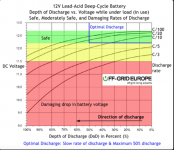Pudsey Bear
Full Member
- Messages
- 15,882
YMMV ???
Meaning of YMMV in Englishwritten abbreviation for your mileage may vary: used, for example on social media and in text messages and emails, to mean that you understand people may have a different opinion or experience to yours: Their first album is better, but of course YMMV.YMMV ???
You must leave the charger on over night to let the voltage rise, also make sure something is not drawing current away, could also be a duff diode in the alt, get it tasted.The second replacement Ctek arrived on Thursday, I connected it up and it is still only putting out 13.2v.
Ctek say it should put out 14.2v.
Another thing, I bought a new ciggy socket voltage display as I wasn't 100% sure of the old one, they both do the same thing though when I turn on the sign, they show 11.9v then it slowly climbs up to 13.2v after about 5 minutes, and off charge again slowly up to 12.4/5/6v
The manual isn't very good
file:///C:/Users/dell/Dropbox/Van%20stuff/PDFs%20for%20Ben/CTEK_MXS5_User_Manual.pdf
It's been on since Thursday, as said ign on, it goes up over 14v if I start the engine, and I am not tasting anything.You must leave the charger on over night to let the voltage rise, also make sure something is not drawing current away, could also be a duff diode in the alt, get it tasted.
Yes, quite a few need to see >8V before they go on - could be a deliberate design so they won't try and charge a 6V motorcycle battery? Some need >4V.SOME ,battery chargers will not charge a flat battery as they need to read a battery voltage to turn on the charger , this can be overcome by connecting another battery to flat battery and charger will switch on
New battery should be at 12.7v, if down that far its fookerd.I'm just a bit wary, the Ctek having died once and according the their tech the replacement not performing as it should but this one is exactly the same it is looking like I have a spare now, they asked me to cut both leads off the original one but not the second, I'm happy that the display is reading over 12.5v, just curious as to why it takes a while to get to that figure.
The new battery was at 11.9v when it arrived so not suspecting a problem there.

When the battery arrived or when the latest premium brand (buy once, keep getting replacements) charger arrived?I'm just a bit wary, the Ctek having died once and according the their tech the replacement not performing as it should but this one is exactly the same it is looking like I have a spare now, they asked me to cut both leads off the original one but not the second, I'm happy that the display is reading over 12.5v, just curious as to why it takes a while to get to that figure.
The new battery was at 11.9v when it arrived so not suspecting a problem there.
Absolutely not. Those things test the battery's ability to provide a high current for a short time. They are not a suitable (or even safe) way to test a leisure battery, and they do not ever show the state of charge of the battery or the actual voltage at the terminals.Proper way to test a battery is with a load tester as used in many garages.
That chart isn't relevant for a battery not being discharged (which is what this discussion is about), but it's interesting, nonetheless.New battery should be at 12.7v, if down that far its fookerd.View attachment 71690
You can test at any point if there is nothing switched on. There will be no voltage drop in the wiring if there is no current.I have three, but there is not easy access point for the VB
Used them for years in garages i worked in, always done the trick, we did voltage tests on a crypton tunner.
They are fine for use in a garage, testing a starter battery's ability to start an engine.Used them for years in garages i worked in, always done the trick, we did voltage tests on a crypton tunner.
